How to choose a gas meter: guidelines for choosing a device for a private house and apartment
The price of energy resources is steadily increasing and is not going to decrease in the foreseeable future.A thrifty owner tries to use them as efficiently as possible. Metering devices will help him with this. They should be installed in all private houses, and, according to innovations in legislation, in apartments.
We will tell you how to choose a gas meter and introduce you to the models of devices used in domestic conditions. Here you will learn what criteria should be used to select a flow meter that records the supply of main gas to the consumer. Taking into account our recommendations, you can choose both the optimal model and the place for its installation.
The content of the article:
Why do you need a gas meter?
Some gas consumers, in the old fashioned way, pay for it according to standards, citing the fact that the cost of a meter with installation is prohibitively high.
Indeed, they have such a right, but economically it is very unprofitable. Why is this happening?
Firstly, the fee according to the standards is initially too high. It is calculated based on maximum gas consumption, which in real life is extremely rare, if not nonexistent.
Payment according to standards takes into account the maximum of all possible gas consumption options for each person living in an apartment or house. If there are two or three residents, or even more, the amounts are not small.
In addition, the state is interested in ensuring that consumed resources are recorded by metering devices, therefore the current legislation provides for increasing coefficients that increase gas fees according to standards. Over the course of several years, this coefficient gradually increases until it reaches a maximum.

Whereas installing a meter involves paying only for the amount of gas actually consumed. Practice shows that it differs significantly from that calculated according to the standards. Accordingly, the fee is significantly reduced.
The real difference in payment allows you to quickly recoup the cost of purchasing and installing a metering device, and subsequently receive significant benefits from it.
For those who have autonomous gas heating, installing a meter provides another advantage. They can use their heating equipment regardless of the beginning or end of the heating season.
Consumers who do not have metering devices are automatically disconnected from the gas supply after the end of the heating season until it begins. Meter installation solves this problem.
Before contacting gas workers with a request to install and seal a gas flow meter, you need to select and buy a device. And this is not easy, because there are an impressive number of them on the market now. According to the principle of operation, all gas consumption meters are divided into the following groups:
Types of metering devices
Equipment for metering gas consumption is varied. There are several types of such devices, differing in their operating principles. Let's look at each in more detail.
Option #1 - rotary or rotational
It is a chamber metering device with eight-shaped rotors, which are used as converting elements.
Structurally, the device consists of a housing, counting and transmission mechanisms. Inside the housing there are two identically sized rotating rotors in the shape of a figure eight. One of them is connected to the transmission and counting mechanisms.
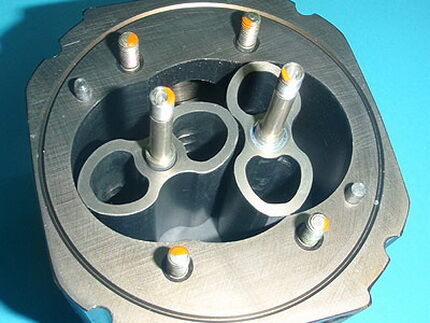
The housing is equipped with an inlet or upper and an outlet or lower gas pipe. When the latter begins to flow inside the housing, a pressure difference arises, which causes the rotors to rotate.
They do this synchronously, for which the gear wheels fixed in the end boxes are responsible. During rotation, the rotors touch each other with their side surfaces, which is necessary for the counting process.
The volume of gas that is displaced by one rotor during half its revolution is equal to the volume corresponding to the amount of gas limited by the inside of the housing and the surface of the rotor in a vertical position. For every full revolution of the two rotors, four such volumes are displaced from the housing. Accordingly, the flow rate of gas passing through the meter is easily taken into account.
The advantages of such devices include a significant measurement range and high throughput. At the same time, they are quite compact.
In addition, the devices are durable, non-volatile, and not sensitive to short-term overloads. The noise level they produce is considered average, it is almost unnoticeable. Among the disadvantages, it is worth noting the short verification period. It is only 5 years.
Option #2 - diaphragm or membrane
It is a chamber-type meter used to account for small gas flows. The device body is divided into two parts. At the top there are gas inlet and outlet pipes.
Both body fragments are securely fastened together. Special gaskets are installed between them and a paste-like sealant is placed. Also inside the case there is a diaphragm-type measuring mechanism.
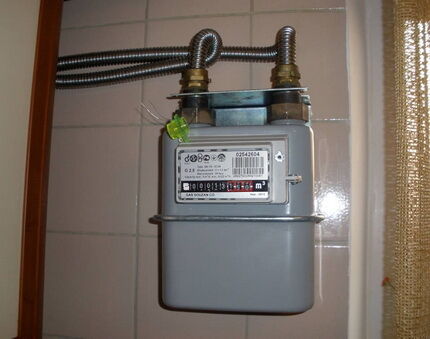
It consists of two chambers reminiscent of a blacksmith's bellows. Each of these chambers is connected to a common valve spool mechanism by means of levers and cranks. Gas supply channels pass through it.
The number of cameras may vary; the accuracy and class of the measuring device depend on their number.The spool mechanism is connected via a shaft to a counting device mounted on the housing.
When gas enters the device, it is alternately displaced from the bellows chambers. This leads to alternate movement of the diaphragm partitions. As soon as one chamber is filled, the spool mechanism switches and it begins to release gas.
This cycle is repeated many times. It is accompanied by movement of the diaphragms. This movement triggers a counting mechanism that takes into account the amount of gas that has left the chambers in a certain unit of time.
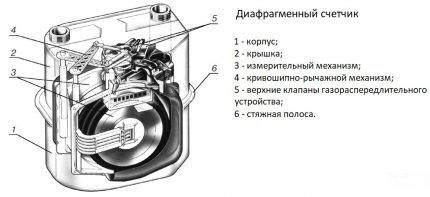
Membrane meters are distinguished by high measurement accuracy. The simplicity of the design gives them a significant service life, which is at least 20 years. Such devices are extremely easy to maintain and economical.
However, if necessary, it is very difficult to disguise a membrane counter. Another disadvantage is the fairly high cost of the equipment. The verification period for diaphragm-type devices is 10 years.
Option #3 - turbine meter
The device received its name due to the presence of a small turbine in it, the wheel of which rotates under the pressure of the gas flow entering the device.
Structurally, the equipment is a pipe fragment equipped with flanges. The following mechanisms are located sequentially in the device body, starting from the inlet pipe: a jet rectifier and the turbine itself with rotation supports and a shaft.
For smooth operation of the bearings, lubrication is necessary, so a pump unit is mounted on the meter housing. With its help, oil is supplied to the rotating elements through special tubes.
The operating principle of the measuring device is quite simple. The speed of the rotating turbine is transmitted through a reduction gear to a special counting mechanism mounted outside the gas cavity.
Turbine meters can be equipped with additional detectors to measure pulses, temperature or pressure. In addition, the measurement process can have three degrees of automation. The lack of automation assumes that the user independently reads the instrument readings.
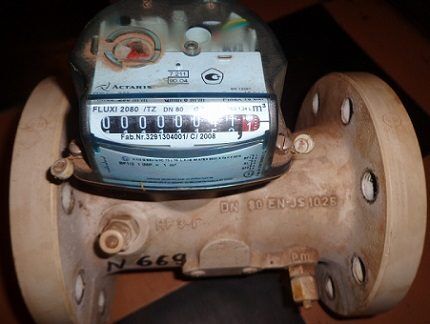
Semi-automatic measurements assume that control is carried out by a computing device, but manual correction of indicators, settings, etc. is possible. Full automation of measurements assumes that the readings of the measuring device are received by a computing device, which processes them and transmits them to the accounting center.
The advantages of turbine meters are energy independence, reliable design and ease of maintenance. The device can work with gas that is not of the highest purity level. The noise level emitted by the device can be characterized as low. Manufacturers produce turbine meters in a large number of standard sizes.
The disadvantages of the equipment include measurement errors.If the device operates continuously, the error is minimal; if in pulsating mode, measurement distortion increases significantly. The verification period is 8 years.
You can check the main gas meter without removing the device from its original place. How such testing is performed is described in detail in our recommended article.
In order to obtain the most accurate readings from a flow meter that takes into account gas consumption, devices are now being produced that are aimed at a specific type of consumer:
Criteria for choosing the optimal meter
After getting acquainted with the different types of gas meters, you can decide which one to choose for your home. However, in addition to the type of device, there are several other important parameters that must be taken into account when choosing. Let's look at each of them in turn.
Device throughput
By capacity we mean the maximum amount of a gas mixture that the equipment can measure per unit of time. Usually this is one hour of work. This value must be compared with the maximum gas consumption in the house or apartment.
To do this, you need to calculate the total gas consumption. To do this, you need to add up the average consumption of all devices using it.

It will be much easier to do this if you find the technical documentation for each device and take the required value from there. The manufacturer must indicate the maximum consumed gas volume in the equipment passport.
Total consumption is calculated for all gas appliances in the apartment, even if some of them, in the owner’s opinion, are used extremely rarely.
Moreover, if you plan to purchase and install additional gas equipment, its consumption must also be added to the total. Then you won’t have to subsequently buy and install a new meter.
Having determined the value of the maximum gas consumption, you need to select a flow meter with a capacity greater than the obtained value. This will be very easy to do if you read the device labeling correctly. It represents the letter G, next to which there are numbers.
Thus, a meter marked G1.6 has a throughput capacity of 1.6-2.5 cubic meters per hour, G2.5, accordingly, can pass 2.5-4 cubic meters per hour, G4 - from 4 to 6 cubic meters, G6 - from 6 to 10 and G10 – from 10 to 16 cubic meters. m per hour. Based on this marking, a suitable measuring device is selected.
Design features of the device
The variety of installation locations for gas meters determines their design features. The first thing you need to pay attention to is the direction of gas movement. It can be fed from the left or from the right.
Depending on this, devices are divided into left- and right-handed. It is necessary to clearly understand the connection diagram of the meter, since it is physically impossible to install left-sided equipment on the right side and vice versa.
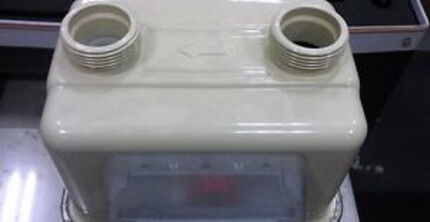
The direction of gas movement is necessarily indicated by an arrow on the device body. It must be strictly observed.
Another important point is the thread diameter of the connecting pipe of the device.It must exactly match the dimensions of the pipe through which gas is supplied and on which the meter will be installed. For apartment buildings, the standard pipe diameter is ½ inch.
In buildings constructed according to an individual project, these dimensions may vary. The most common supply pipes are ½, ¾ or 1 inch in diameter. Depending on the thread diameter, union nuts are selected for mounting the device. They must correspond exactly to the installation dimensions.
It is also important that the interaxial distances of the threaded connections coincide; they also vary. For devices with a top-type connection installed on a horizontal pipe, this distance varies from 110 to 250 mm.
Devices with high throughput, which are installed where the number of consumers is more than two, can have a center-to-center distance of more than 250 mm.
Presence or absence of a thermal corrector
A standard gas meter can operate in a temperature range from -40 to +40 °C. However, the correctness of the measurements he made under such conditions may be questionable.
This is due to the fact that the gas mixture tends to expand or contract when the temperature increases and decreases. Pressure in the system also plays a role. Therefore, we can only talk about the correct operation of the measuring device under conditions of normal pressure and temperature of 20 °C.
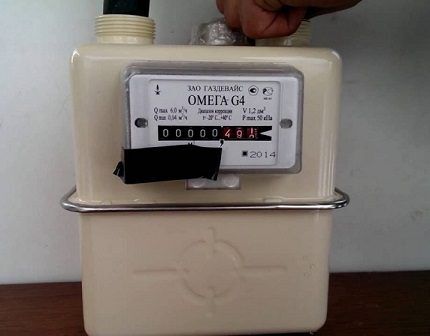
It is clear that such conditions do not always exist. Especially if the gas meter is installed on the street, which is not prohibited by law.During the cold season, gas services can suffer serious losses, since the actual volume of gas consumed increases, and its consumption according to the meter remains virtually unchanged.
In the hot season, economic losses are already borne by consumers who have to pay for increased gas consumption, although the actual volume of gas supplied has not changed. To avoid this, a special device called a thermal corrector is used. It does not allow changes in temperature and pressure to affect gas consumption.
Thus, under any conditions, the measurements made by the meter are as correct as possible. You need to know that gas meters equipped with a thermal corrector cost much more than standard ones. Therefore, they should be installed only where difficult operating conditions are expected.
For example, in the kitchen of a city apartment, where a stable, comfortable temperature is maintained, this device will be clearly superfluous. Whereas the installation of such equipment on the street is justified and necessary.
The importance of the date of manufacture
The current federal law regulates the regular verification of metering devices. Moreover, the first of them is carried out at the manufacturing plant immediately after the product is released. Information about it is entered into the technical passport of the device.
Thus, it turns out that the date of the next periodic verification is counted from the date indicated in the documents. Therefore, when purchasing a new device, you need to carefully study the technical documentation and check the date of first verification.
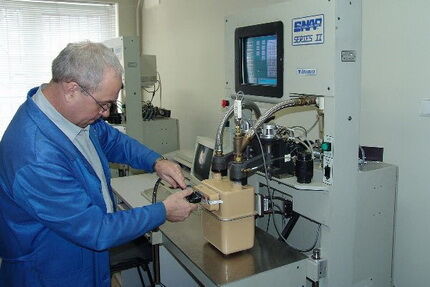
It happens that a device “stays” in a warehouse and goes on sale two, three, or even five years from the date of manufacture. Consequently, its verification interval is automatically reduced by this period. And it turns out that the newly installed meter is already subject to verification or replacement. This can be an extremely unpleasant surprise for an inattentive owner.
The contract concluded with the gas service must indicate the date of the first verification of the measuring device. Gas workers closely monitor verification deadlines, but they are not obliged to inform users about them.
Therefore, if a consumer, due to inattention, ignorance, or for any other reason, missed the deadline for calibrating his flow meter, he will be issued an invoice calculated according to the standards.
The calibration interval for gas meters of different types differs significantly. But in any case, it is less than the service life of the device.
To carry out verification, the equipment is dismantled and sent to a specialized workshop, where specialists will check it and issue a conclusion on the possibility of further use. If the device is recognized as suitable for use, a special mark must be made in its technical passport.
Installation location of the measuring device
You can choose a gas meter for your apartment or house yourself, but it is better to entrust this important task to specialists from the gas service. They will competently analyze the operating conditions of the device and offer models of devices suitable for a specific apartment.
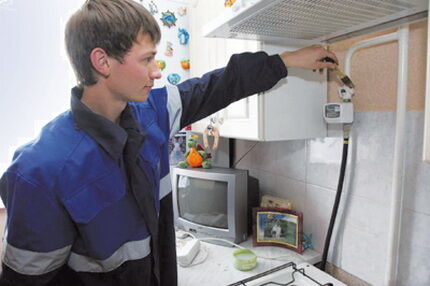
However, if you want to do everything yourself, when choosing a device you should consider the following significant points:
- Maximum amount of gas consumed by residents. It depends on the required throughput of the model. It is calculated taking into account all gas appliances in use.
- Location of the metering device. You must choose immediately to determine the design features of the meter.
- Equipment noise level. It is advisable to purchase the least noisy model.
- Intervalidation interval. The longer it is, the better.
- Service life and reliability of the model.
Important Note. You should not purchase a meter with a thermal corrector for an apartment, no matter how hard sellers try to advertise it. This is a waste of money.
Actually, choosing a gas meter for a private house is practically no different from choosing a device for an apartment. But there is a small nuance here. Construction regulations require the installation of gas meters not indoors, but outdoors.
The owner of gasified private property should know about the rules for the location of the meter in relation to equipment and structures:
Many owners of private houses connected to main gas, do just that. They install a meter on the street. In this case, you should choose only equipment with a thermal corrector, otherwise problems may arise with paying for gas.
In addition, care should be taken to protect the equipment casing, otherwise unfavorable weather conditions will quickly damage the meter. The easiest way is to purchase a special installation cabinet like box for electrical machines. It is convenient for use and safe for him to place the device.
Conclusions and useful video on the topic
Video #1. How a membrane gas meter works and works:
Video #2. How to choose a gas meter:
Video #3. Gas meters for home and apartment:
A gas meter is necessary in every home. It helps to use energy resources as efficiently as possible and, ultimately, significantly save money from the family budget. In order for the device to work correctly and for a long time, it is important to choose it as wisely as possible.
You should not completely trust sales consultants who are interested in selling their goods. It is better to carefully study the technical documentation and make an informed choice yourself.
Please write comments in the block below. Share your own experience in selecting and using gas meters.Leave posts with your opinions, questions and photographs on the topic of the article.




You need to choose your gas meter wisely; you can’t just change it. It all depends on your preferences and where to place the counter. A temperature-corrected meter placed outside will help you save up to 3% on your gas bill compared to the same one located inside the house. Also take meters that take into account the seasonal coefficient, this is another 5-10% savings. In an environment where gas prices are constantly rising, this saving will come in handy. and you don’t have to choose: freeze or heat to the fullest during cold winters.
seasonal coefficient? What is this? there is no such thing for the population. Only industry has a seasonal coefficient, and only for exceeding the limit
Here in Makhachkala, especially in winter, they take a winter coefficient, so you think it’s better to buy a gas meter with temperature correction, but how it works in the summer is not clear, that is, whether it will charge more gas during this period than the winter one, and that’s the whole problem
Our gas service will not allow us to install any meter; it must undergo mandatory verification and be of the established standard, like everyone else. We’ve had a diaphragm one in our house for a long time, it’s really more profitable and I heat when I want, I don’t wait for the heating season to start, so I don’t freeze. The gas service also connected, so I was sure that they would do everything right.
Hello! I contacted the gas service to install a (primary) gas meter in a private house on the street, the technician said that we are not allowed to install a mechanical meter on the street, only people with many children and veterans have the right to install this meter, is this true?
no not true, but when installed outdoors without temperature compensation, an increasing factor will be applied to the gas price
Which meter should I replace the GALLUS G4 3\4 thread 2000 with?